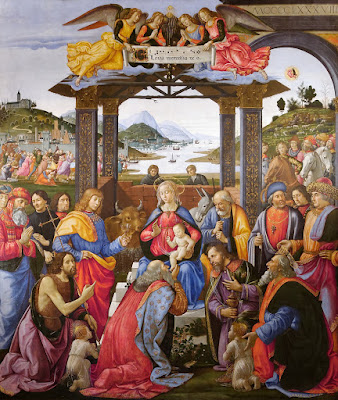 |
| Filippo Lippi Seven Saints ca. 1450-53 tempera and oil on panel National Gallery, London |
 |
| Pesellino St Mamas and St James the Greater (detail of Santa Trinità Altarpiece) ca. 1455-60 tempera and oil on panel National Gallery, London |
 |
| Andrea del Verrocchio and Leonardo da Vinci Baptism of Christ ca. 1468-75 tempera and oil on panel Galleria degli Uffizi, Florence |
 |
| Andrea del Verrocchio and Leonardo da Vinci Baptism of Christ (detail) ca. 1468-75 tempera and oil on panel Galleria degli Uffizi, Florence |
 |
| Filippino Lippi Adoration of the Magi ca. 1480 tempera and oil on panel National Gallery, London |
"There was at this same time in Florence a painter of most beautiful intelligence and most lovely invention, namely, Filippo [known as Filippino], son of Fra Filippo [Lippi] of the Carmine, who, following in the steps of his dead father in the art of painting, was brought up and instructed, being still very young, by Sandro Botticelli, notwithstanding that his father had commended him on his death-bed to Fra Diamante, who was much his friend – nay, almost his brother. Such was the intelligence of Filippo [the son, Filippino], and so abundant his invention in painting, and so bizarre and new were his ornaments, that he was the first who showed to the moderns the new method of giving variety to vestments. and embellished and adorned his figures with the girt-up garments of antiquity."
– from Lives of the Painters, Sculptors and Architects by Giorgio Vasari (1568), translated by Gaston du C. de Vere (1912)
 |
| Filippino Lippi Adoration of the Magi (detail) ca. 1480 tempera and oil on panel National Gallery, London |
 |
| Filippino Lippi Adoration of the Magi (detail) ca. 1480 tempera and oil on panel National Gallery, London |
 |
| Filippino Lippi Adoration of the Magi (detail) ca. 1480 tempera and oil on panel National Gallery, London |
 |
| Bartolomeo di Giovanni The Argonauts in Colchis 1487 tempera and oil on panel National Gallery, London |
 |
| Bartolomeo di Giovanni The Argonauts in Colchis (detail) 1487 tempera and oil on panel National Gallery, London |
 |
| Bartolomeo di Giovanni The Argonauts in Colchis (detail) 1487 tempera and oil on panel National Gallery, London |
 |
| Domenico Ghirlandaio Adoration of the Magi 1488-89 tempera and oil on panel Ospedale degli Innocenti, Florence |
 |
| Domenico Ghirlandaio Virgin and Child with young St John the Baptist and Angels ca. 1490 tempera and oil on panel Musée du Louvre |
"Our account of the Florentine Quattrocento ends with Domenico Ghirlandaio (1449-1494), who, in a career even briefer than that of Filippino [Lippi], rose from still-unidentified artistic origins to become the leading personality in the Florentine School, if measured by the standard of worldly success. Domenico, together with his brother Davide and their brother-in-law Bastiano Mainardi, not to mention an army of assistants, captured the major commissions for public painting in Florence – frescoes and altarpieces – and many lucrative portrait commissions as well. . . . The scientific pursuits of Pollaiuolo and Verrocchio might appeal to Lorenzo the Magnificent, the arcane researches of Botticelli to Lorenzo di Pierfrancesco and his friends, but the ordinary Florentine businessman knew what he liked and may even have been irritated by so much fierce knowledge on the one hand and so much wild imagination on the other. Ghirlandaio's prose style suited the successful merchant perfectly. Its subsequent fate is instructive. When Quattrocento art was rediscovered by nineteenth-century critics, Ghirlandaio's meticulous and convincing view of the life about him impressed a generation that never quite understood Masaccio and cast only a scornful glance in the direction of Uccello and Piero della Francesca. Then came the revolution of "Form" in the wake of Cézanne, Picasso, and the Cubists, and that of "Expression" after Van Gogh, Rouault, and Nolde; and Ghirlandaio fell from grace a second time. After all, he had made no discoveries about form or space, and he often demonstrated what little interest he had in drama. So Ghirlandaio – who to Ruskin was the master of painting in Quattrocento Florence – dwindled to minor significance in twentieth-century eyes."
– Frederick Hartt, History of Italian Renaissance Art, originally published in 1969, revised by David G. Wilkins and reissued by Abrams in 1993
 |
| Francesco Granacci Rest on the Flight into Egypt with young St John the Baptist ca. 1494 tempera and oil on panel National Gallery of Ireland, Dublin |
 |
| Raffaellino del Garbo Portrait of a Man ca. 1495 tempera and oil on panel National Gallery, London |